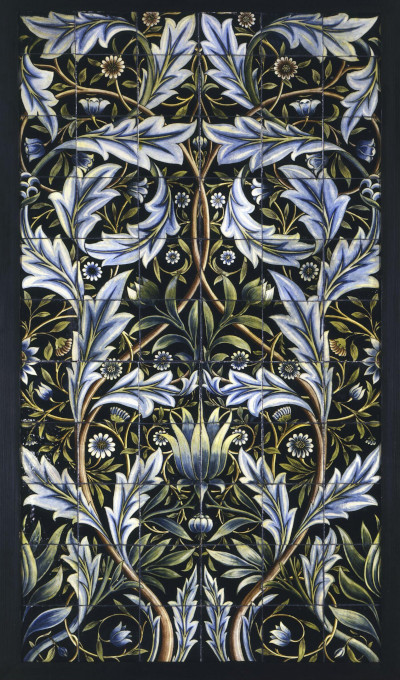William Morris' floral designs could be used in all manner of different products, one of which were ceramic bathroom tiles. This tile panel was produced for the architect of Membland Hall in Devon in around 1876.
The artist would call upon the help of William de Morgan in order to complete these tiles as he was not as experienced within this medium as with other disciplines. The design itseld was entirely the work of Morris, with assistance helping to produce these hand-painted earthenware ceramic tiles. There were sixty six tiles in total, all carefully designed in order to fit together once installed. Morris' intricate designs with floral patterns meant great precision was needed to avoid issues arising once the tiles were lined up togther within the manor's bathroom. Sadly, the hall would later be demolished and only a few elements of its interior were saved. The V&A Museum plus the Morris Gallery, both situated in London, have elements from the original project. It was rare for Morris to work alongside De Morgan, adding a great significance to this collaboration. Some have suggested that Morris' temporary partner was not quite as precise and demanding in the materials that he used, and so was happy to combine a mixture of tiles for the project from different sources.
Either way, the end result was impressive and features a stunning display of intertwining plants and flower heads. Tones of green and blue leave a striking impact, but without being too bright. The style would work within a contemporary home today quite easily, and this underlines how Morris has been able to enjoy a strong relationship all these years later. This set of tiled panels can be found in the Ceramics Collection of the V&A, rather than the specialist section which focuses entirely on the artist himself. Most are more aware of his contributions to fabric printing, furniture and painting rather than ceramics, but some mention of his work in this field has appeared within recent publications on the artist. The V&A continue to draw attention to the full body of work that he produced across his career, regularly rotating and amending curated displays to offer different angles for repeat visitors.
William Morris attempted to learn as many different skills as he could but he understood that sometimes it made more sense to bring in specialists for the odd project. In this case, when tasked with providing bathroom tiles he decided it best to work alongside De Morgan, and this would have helped him to deliver the project with far fewer issues. Over time his intention would probably have been to glean as much from this master as possible so that potentially he could work alone in future. He also enjoyed strong support within his own company from others who he worked alongside much more regularly and so it was rare for him to have to look outside the company for additional help. Despite only rarely being involved in ceramics, Morris' Panel of Ceramic Tiles is still regularly featured within ceramic publications because of the fame that he achieved within the art world more generally.




